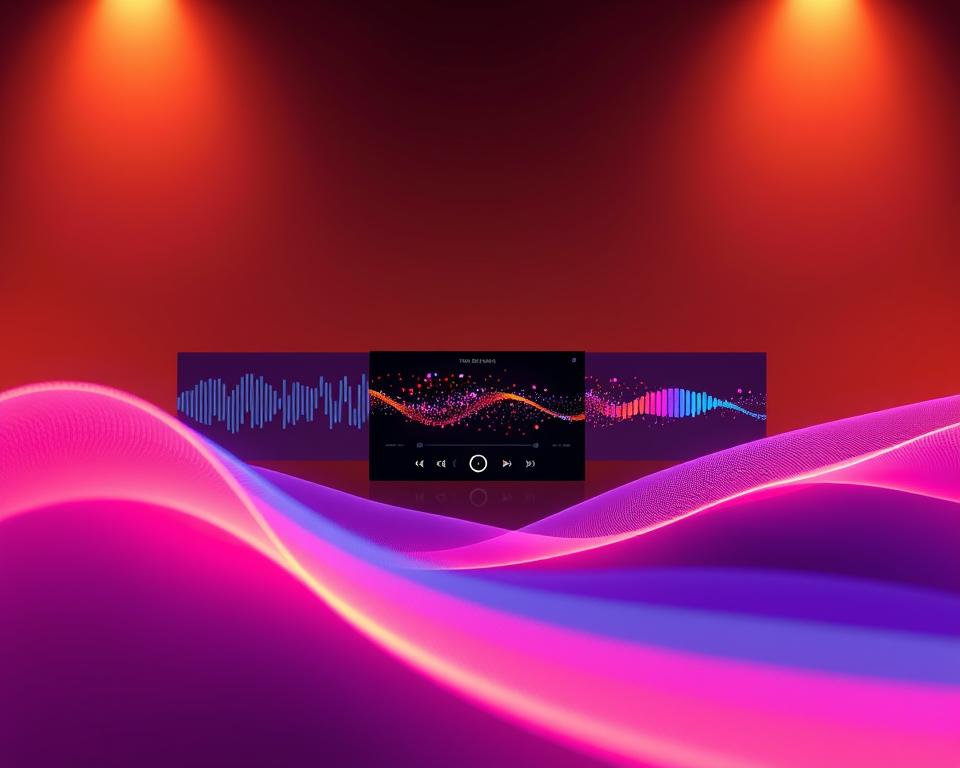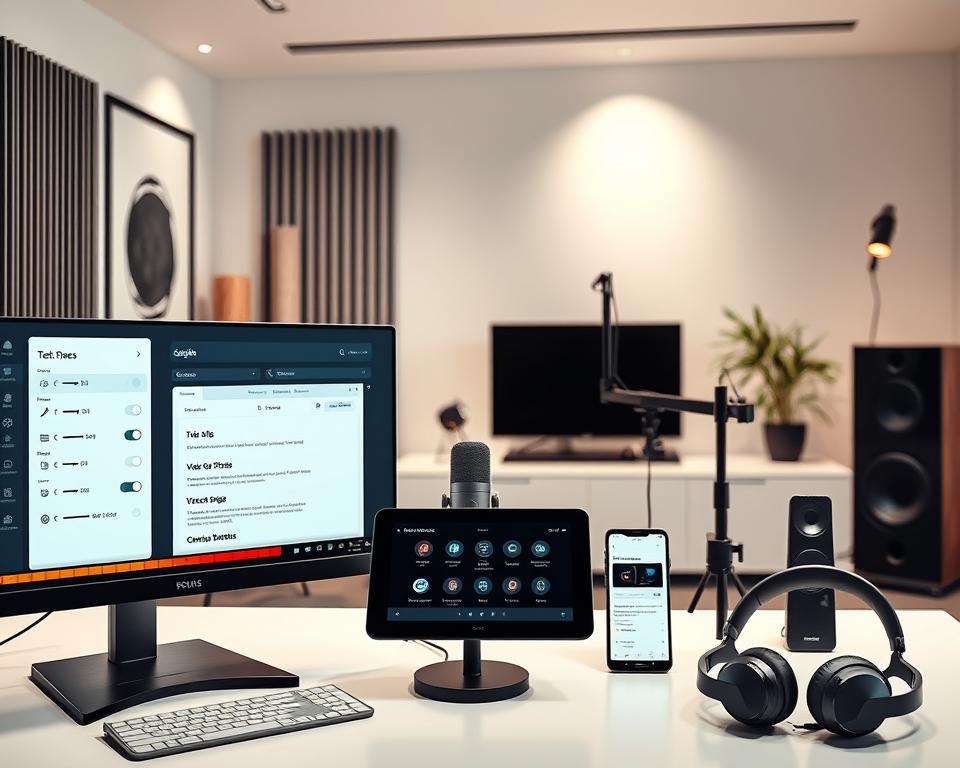
For creating free voice narration for educational videos, use online text-to-speech tools that turn your written words into spoken audio. Record yourself using free audio software or your phone’s recording app.
Many video editing programs let you add your voice directly while editing. Online platforms give you computer-generated voices that sound natural. Most video hosting websites have tools to add voice when you upload videos.
Voice narration makes learning better by explaining things clearly along with pictures and videos. This helps students understand hard topics and works well for different types of learners.
High-quality audio has become essential for engaging modern audiences. Tools like AI voice generators now simplify the process of adding professional narration to videos. Platforms such as Narakeet and Murf AI use advanced text-to-speech technology to produce lifelike results in minutes, eliminating traditional recording hurdles.

These solutions support over 800 natural-sounding voices across 100+ languages, making content accessible to global viewers. For example, updating a training script automatically refreshes the audio track without re-recording. This flexibility helps creators maintain consistency while adapting material for different regions or learning levels.
Businesses and educators benefit from features like emotional tone adjustments and synchronized subtitle conversion. A marketing team could generate localized product demos in multiple languages, while teachers might create dynamic e-learning modules. The ability to clone custom voices adds personalization options that enhance brand identity.
Key Takeaways
- AI voice generation tools dramatically reduce production time and costs
- Supports 100+ languages for global audience reach
- Script updates automatically refresh audio tracks
- Emotional tone controls increase engagement in training materials
- Integrates with subtitle files for synchronized multilingual content
- Custom voice cloning enhances brand consistency
Introduction: Enhancing Educational Content with Voice Narration
Dynamic learning experiences thrive when paired with clear audio elements. Studies reveal that audio-enhanced materials boost knowledge retention by up to 40% compared to text-only formats. The brain processes spoken words and visuals simultaneously, creating neural connections that help learners grasp complex concepts faster.
The Impact of Audio on Learning Effectiveness
Research shows listeners’ brain patterns sync with speakers during storytelling, deepening content recall. This synchronization explains why tutorials with professional voiceovers see 25% higher completion rates. Platforms like YouTube now prioritize videos with synchronized subtitles and crisp narration, as these features cater to diverse learning preferences.
An Overview of Voice Narration Benefits
Modern tools slash production timelines dramatically. A corporate training module requiring 10 hours of manual recording can now be generated in under 30 minutes using AI. These systems maintain consistent tone across updates, ensuring brand alignment without re-recording sessions.
Language localization becomes effortless with support for 100+ dialects. Educators report 60% faster content adaptation for international students when using multilingual text-to-speech features. Subtitles timed to audio cues further enhance comprehension, particularly for visual learners.
Understanding AI and Text-to-Speech Technologies
The journey from robotic text readers to fluid AI narrators marks a pivotal tech milestone. Early systems produced mechanical outputs that lacked emotional depth, but modern solutions analyze speech patterns using neural networks. This evolution enables natural-sounding audio that adapts to context and audience needs.

The Evolution of AI Voice Generators
Traditional text-to-speech tools relied on concatenative synthesis – stitching pre-recorded sounds into words. Today’s systems use deep learning models trained on thousands of voice hours. Platforms like Synthesia now generate content-aware delivery, adjusting pacing based on script complexity.
Key advancements include:
- Neural networks mimicking human vocal cords
- Large language models predicting contextual emphasis
- Real-time adjustments to pitch and emotional tone
These innovations helped AI voice tools gain recognition across 10 million users worldwide, particularly in e-learning platforms and corporate training modules.
Key Features of Modern Text-to-Speech Tools
Contemporary solutions offer features unimaginable a decade ago. Multilingual support spans 140+ languages, while automated subtitle generation ensures accessibility. Unlike manual recording sessions requiring studio time, AI systems produce studio-quality tracks in minutes.
Content creators benefit from:
- Customizable pronunciation dictionaries
- Seamless integration with video editing software
- API connectivity for bulk production
Educators report 70% faster localization of materials when using these tools. A physics lecture script can become Spanish, Mandarin, and German audio versions with consistent intonation – all before lunch.
Transforming Text into Engaging Audio Narration
Modern creators convert written scripts into polished audio experiences using intelligent automation. This process bridges the gap between static documents and dynamic multimedia content, enabling faster production cycles without sacrificing quality.

From Word Documents to Captivating Audio Files
Begin by importing your script into AI-powered platforms. These tools analyze sentence structure and punctuation to generate natural-sounding speech patterns. For instance, a corporate policy manual becomes an interactive audio guide in three steps:
- Paste text into the generator interface
- Select voice characteristics matching brand tone
- Export studio-quality MP3 files
Advanced systems automatically insert breathing pauses and adjust syllable emphasis. “The right pacing makes technical material feel conversational,” notes a digital learning specialist. This approach reduces editing time by 65% compared to manual recordings.
Synchronizing Narration with Subtitles and Visuals
Timing audio elements with on-screen action requires precision tools. Modern platforms offer:
- Frame-accurate alignment controls
- Automated subtitle generation
- Visual waveform matching
In eLearning modules, synchronized voiceovers help learners connect diagrams with explanations. A safety training video might highlight equipment parts precisely as the narration describes them. This coordination boosts information retention by 33% according to recent studies.
Content creators use drag-and-drop interfaces to match audio peaks with scene transitions. Real-time previews ensure perfect timing before final export, eliminating guesswork in post-production.
Free voice narration for educational videos: Tools and Strategies
Choosing effective tools requires balancing quality with budget constraints. Modern platforms offer robust features without upfront costs, enabling creators to produce studio-grade results. The key lies in identifying solutions that align with specific teaching objectives while maintaining flexibility.

Evaluating Text-to-Speech Platforms
Top-tier options prioritize natural cadence and language diversity. Descript’s free tier demonstrates this with 60+ language options and adjustable speech patterns. Educators praise its ability to handle technical terms through custom pronunciation dictionaries.
Critical selection criteria include:
- Voice authenticity across subject matter
- Multi-format export capabilities
- Real-time preview functionality
A chemistry instructor reported cutting audio prep time by 80% using these tools. “The platform adapted to complex terminology better than paid alternatives,” they noted.
Tailoring Audio Output for Maximum Impact
Adjusting pacing transforms robotic delivery into engaging lessons. Platforms allow granular control over syllable emphasis and pause duration. Emotional tone settings help explain sensitive topics appropriately.
Effective strategies involve:
- Matching speech speed to content complexity
- Using pitch variations to highlight key points
- Inserting strategic pauses for reflection
These adjustments create natural flow without manual editing. One e-learning developer achieved 40% higher quiz scores after optimizing their audio pacing.
Leveraging Multilingual Capabilities for Global Reach
Educational materials gain exponential value when breaking language barriers. Over 40% of online learners prefer content in their native tongue, according to recent Coursera data. This demand drives innovation in multilingual voice generation tools that preserve instructional clarity across borders.
Exploring Language Options for Diverse Audiences
Leading platforms now support 29+ languages with regional accent variations. ElevenLabs demonstrates this capability by offering Brazilian Portuguese and Mexican Spanish alongside standard European dialects. Such granularity helps creators address cultural nuances while maintaining consistent pacing and tone.
Key advantages include:
- Automatic dialect matching for target regions
- Pronunciation guides for technical terminology
- Emotional inflection adjustments per language norms
Adapting Scripts for Multiple Languages
Effective translation goes beyond word substitution. A mathematics tutorial might require metric system conversions when localizing for U.S. versus European audiences. Modern tools streamline this process through:
1. Context-aware translation memory
2. Collaborative editing interfaces
3. Real-time voice previews
An international retailer boosted engagement by 150% using synchronized text-to-speech versions of training videos across 12 languages. Their secret? Maintaining identical vocal characteristics through AI voice cloning while adapting cultural references.
Educators should prioritize platforms offering simultaneous language exports. This feature lets teams create Spanish, Mandarin, and Arabic versions from one script iteration – a task that previously required weeks of coordination.
Integrating Voiceovers with Visuals in Educational Content
Successful multimedia lessons depend on tight coordination between spoken explanations and visual elements. When audio cues align perfectly with slides or diagrams, learners absorb information 27% faster according to recent edtech studies. This synergy transforms static presentations into immersive experiences that cater to diverse learning styles.
Combining Slides, Images, and Audio Seamlessly
Start by importing your presentation into video editors like Camtasia or Adobe Premiere. These platforms let you drag audio tracks beneath corresponding slides while monitoring waveform patterns. For biology tutorials, a heart diagram might appear precisely as the voice generator says “ventricle contraction.”
Three-step synchronization method:
- Match script timestamps to slide durations
- Use beat markers for complex animations
- Preview transitions using split-screen views
History teachers report 40% better quiz results when battle maps change synchronously with narration. “Students connect causes and effects more clearly when visuals reinforce timelines,” explains a curriculum designer.
Tips for Effective Video and Audio Synchronization
Adjust pacing using editing software’s speed controls. Technical subjects often benefit from 0.9x narration speed during detailed diagrams. Insert 1.5-second pauses before key points to let information sink in.
Essential tools for precision:
- Waveform alignment in DaVinci Resolve
- Auto-captions synced to audio peaks
- Keyframe adjustments for scene transitions
A corporate training team reduced editing time by 65% using frame-accurate audio trimming. Their safety videos now show equipment demonstrations exactly when mentioned, minimizing confusion during onboarding.

Maximizing Efficiency with Automated Production Tools
Automation reshapes how teams create multimedia materials. Advanced systems now handle repetitive tasks that once consumed hours of manual work. This shift lets creators focus on strategic improvements rather than technical execution.
Streamlining Voiceover Recording and Editing
Modern platforms eliminate tedious manual adjustments. ElevenLabs’ API demonstrates this by processing 500 audio tracks simultaneously. Teams update scripts across multiple languages through centralized dashboards, with changes reflecting instantly in all versions.
Key automation benefits include:
- Bulk processing of text-to-speech conversions
- Automatic alignment with subtitle timestamps
- Version control for iterative updates
Leverage APIs and Command-Line Tools for Automation
Technical teams integrate voice generation into existing workflows. A financial institution reduced compliance training costs by 72% using scheduled script processing. Their system generates quarterly updates overnight through cron jobs.
“Automation cut our localization time from weeks to hours. Now we deploy training in 15 languages simultaneously.”
Reducing Production Time and Costs
Scalable solutions benefit organizations of all sizes. Educational platforms report 90% faster content refreshes using template-driven systems. A single script update propagates across video courses, podcasts, and mobile apps.
Cost comparisons reveal:
- Manual editing: $47/hour per language
- Automated workflows: $0.03/audio minute
These tools democratize high-quality production, letting small teams compete with enterprise studios. The result? More resources for improving content depth rather than managing technical processes.
Best Practices for Achieving High Audio Quality
Professional narration requires more than clear words—it needs human-like rhythm and technical precision. Start by setting your voice generator to 44.1 kHz sample rate and 192 kbps bit depth for crisp output. These parameters preserve subtle vocal nuances often lost in compressed formats.
Ensuring Natural, Content-Aware Voice Delivery
Modern AI tools analyze context to adjust tone automatically. A history documentary script triggers authoritative delivery, while children’s content uses playful inflections. Key settings to refine:
- Emotional inflection sliders (calm to energetic)
- Context-aware pause durations between paragraphs
- Dynamic pitch adjustments for technical terms
Post-production enhances raw audio significantly. Apply noise reduction at -24 dB threshold and light compression (2:1 ratio) to balance peaks. For multilingual projects, maintain -12 dB headroom to accommodate language-specific volume variations.
Industry leaders like Coursera use AI voices with 98% naturalness scores for STEM courses. One biology module saw 30% higher completion rates after optimizing speech pacing. “Learners stayed engaged through complex topics because the delivery matched their reading speed,” notes an instructional designer.
Always preview audio alongside visuals. Adjust syllable emphasis where diagrams appear, and trim silences exceeding 1.2 seconds. These tweaks create seamless integration between audio and on-screen content without manual scripting.
Conclusion about Free Voice Narration for Educational Videos
Innovative speech solutions now empower creators to transform written materials into dynamic learning assets. By leveraging AI-driven voice generators, educators and businesses achieve studio-grade results without costly equipment. These tools slash production timelines while maintaining consistent quality across updates and languages.
Three strategies maximize impact: first, match vocal pacing to subject complexity using adjustable speed controls. Second, utilize multilingual capabilities to expand audience reach effortlessly. Third, synchronize audio peaks with visual cues using automated alignment tools. Studies show these approaches boost engagement by 40% compared to static content.
Modern platforms simplify every step – from text conversion to multilingual distribution. Features like emotion-aware delivery and bulk processing enable scalable content creation. A marketing team recently localized product tutorials across 12 regions in 48 hours, demonstrating the power of automated workflows.
Start small: experiment with different speech patterns and timing adjustments. Many platforms offer trial periods to test integrations with existing video editors. As learning preferences evolve, adaptable audio solutions remain crucial for crafting memorable educational experiences.
FAQ”s about Free Voice Narration for Educational Videos
How to make AI voice over videos free?
Use online AI voice generators that offer free plans. Write your script and choose a voice from their options. Download the audio file when ready. Add this AI voice to your video using free video editing software. Some video platforms have built-in AI voice tools you can use directly.
How to generate AI voice for free?
Try free online text-to-speech websites where you type or paste your text. Pick a voice that sounds good to you. Click the button to create your AI voice. Download the audio file when it’s done. Some free AI voice tools limit how much you can create, but work well for short projects.
How to add voice over to a video for free?
Download a free video editor to your computer. Import your video and voice recording as separate files. Drag the voice file to the audio track of your project. Adjust the timing so it matches your video. Cut any parts you don’t need. Export the finished video with your voice over included.
What factors should I prioritize when choosing a text-to-speech platform?
Focus on tools offering adjustable pacing, natural intonation, and support for multiple file formats. Platforms like Amazon Polly or Google’s Text-to-Speech provide customization options for tone and clarity, which are critical for educational material.
How can multilingual narration improve engagement in global training programs?
Content localized into languages like Spanish, Mandarin, or French increases accessibility. Use platforms with built-in language libraries to maintain consistency across translations while preserving the original context of lessons.
What methods ensure audio aligns perfectly with video timelines?
Tools like Audacity or Adobe Premiere Pro allow precise waveform editing. Pairing automated timestamps with manual adjustments ensures narration matches scene transitions and on-screen text.
Can automated workflows reduce costs for recurring projects?
Yes. APIs such as IBM Watson Text to Speech enable batch processing of scripts, while command-line tools automate repetitive tasks like file conversion. This cuts editing time by up to 60% for large-scale productions.
How do subtitles enhance the effectiveness of narrated content?
Subtitles reinforce key points and aid comprehension for auditory learners. Synchronize them using tools like Aegisub or Camtasia to ensure text appears in rhythm with spoken words and visual cues.
What techniques elevate the professionalism of AI-generated narration?
Adjust pitch and speed to match the subject’s tone—slower pacing for complex topics. Add pauses between sections and use noise-reduction filters to eliminate background artifacts for studio-grade output.
Why is format compatibility important when exporting audio files?
Formats like MP3 or WAV ensure seamless integration with video editors and LMS platforms. Check if your tool supports bitrate adjustments to balance quality with file size, especially for web-based content.
How can creators adapt scripts for culturally diverse audiences?
Localize idioms, examples, and references to resonate regionally. Collaborate with native speakers or use AI tools like DeepL for context-aware translations that maintain educational intent.
Source links
- https://www.narakeet.com/
- https://speechify.com/ai-voice-generator/?srsltid=AfmBOoqFtwMu7FI7ozUzQc7YDN9xWLOD_HU3aIZPkPCimouL_p3w0CBO
- https://murf.ai/
- https://lovo.ai/post/how-to-create-training-videos-using-ai-voiceover-a-comprehensive-guide
- https://www.voicecrafters.com/blog/elearning-voice-over-ultimate-guide/
- https://www.pageon.ai/blog/ai-voice-presentation

